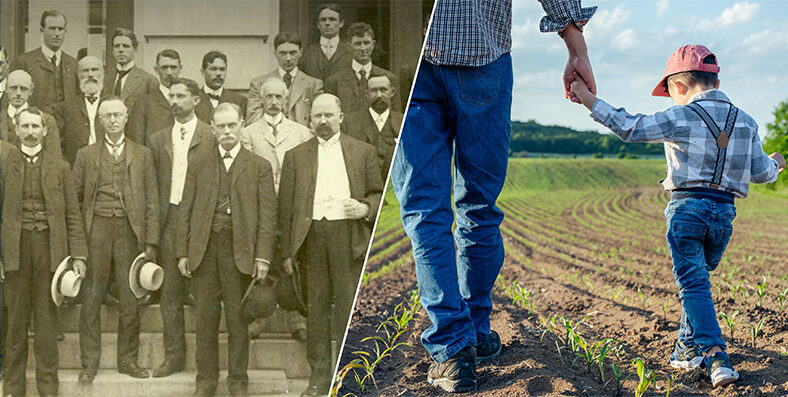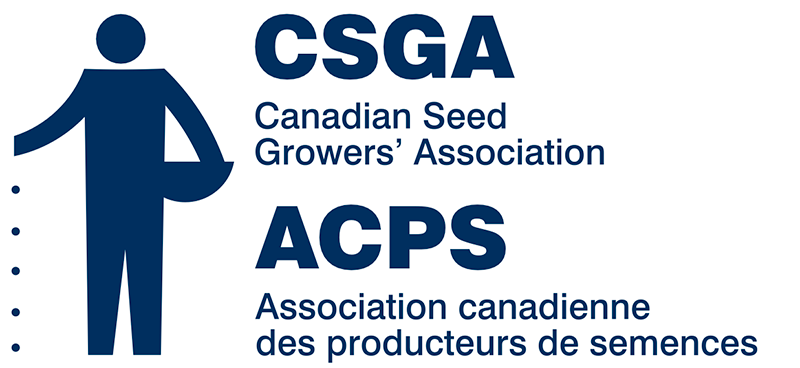CSGA’s History
Celebrating 120 Years of CSGA
2024 was a truly special year for our Association as we celebrated our 120th anniversary. Since our humble beginnings in 1904, we have continuously evolved and provided immense value to Canadian agriculture.
Our heartfelt gratitude goes to all those who came before us. Their hard work and determination laid the strong foundation for the mission we continue to advance today. To our members, past and present – your commitment to excellence has not only shaped the landscape of Canadian agriculture but also established Canada as a global leader in seed quality, integrity, and innovation.
In 2024, we celebrated not only CSGA’s longevity but also the passion and resilience of our incredible community. With a strong 120-year foundation, we look ahead to an even brighter future. We also created a short video to commemorate this milestone — we hope you enjoyed it.
Introduction
It’s been 120 years since CSGA grew from its humble beginnings as a small group working in the Canadian Department of Agriculture that developed a national organization for improving seed stocks to ensure more reliable crop production. Fast forward to CSGA’s network of more than 3,000 seed growers across Canada today, ranging from small family farms to large multinational corporations, all committed to producing the highest quality and genetic purity of certified seed. CSGA has become the national authority for Canadian seed crop standards and certification, upholding with our seed sector and government partners the genetic identity that strengthens Canada’s entire agri-food sector.

With this timeline, we invite our readers to take a deep dive into the vault of CSGA’s past and immerse themselves in the incredible developments, organizational growth, and technological advances that CSGA has undergone and continues to look forward to in years to come. We hope you enjoy it!
The late 1890s: The Emergence of CSGA
J.W. Robertson, the Commissioner of Agriculture and Dairying in the Dominion Department of Agriculture, conceives a plan to encourage farm children to grow better crops from better seed, first donating $100 for prizes, followed by ten thousand dollars donated by Sir William C. Macdonald of Montreal to continue the program and develop a larger seed plot competition amongst farm children. The competition would last three consecutive years.
1904: The Establishment of CSGA
Following the successes of the seed plot competitions in the years previous, the parents of those children express a desire to continue the work of selecting better seed. As a result, the Canadian Seed Growers’ Association (CSGA) was established in 1904, and those parents eventually became the first original members of the Association. In 1904, both the President and Secretary were officials from the federal Department of Agriculture.
1904 – 1922: Early Development
This period involved a transition from a ‘mass selection’ crop improvement organization to a pedigreed seed organization that maintained traceability and the quality of ‘pure line’ selected varieties developed by government plant breeders.
In 1919, Canadian representatives of the Department of Agriculture and CSGA met with U.S. colleagues in Chicago to establish the International Crop Improvement Association (ICIA), which evolved into the Association of Official Seed Certifying Agencies (AOSCA). The primary objective for ICIA was to develop a U.S. system of seed and crop certification standards for quality and varietal purity sufficiently comparable to Canada’s to permit reciprocal recognition of official seed tags and certificates.
In 1921, G. H. Cutler of Alberta became the first President of the ICIA from Canada and, at the first International Seed Grain Show in Chicago, Canadian seed growers won the first five prizes in the Hard-Red Spring Wheat class as well as 1st prize in both the oats and the two-row barley classes.
In 1922, CSGA amassed over 4,000 members.
1923 – 1936 Reorganization
After successive western droughts and crop failures, government established a new Certified class in the Seeds Act.
Provincial Branches of CSGA were established, clarified crop certification regulations were published, and Plant Breeders Committees were established for technical support and to officially review and approve the varieties eligible for certification.
1924: All crops certified by CSGA must now have direct lineage to Breeder seed, making CSGA a truly pedigreed seed organization with full traceability.
In 1924, a CSGA Appeals Board was established for final decisions on the crop kinds and varieties eligible for certification, as well as members’ appeals on the certification of inspected crops.
1937 – 1959 Consolidation
With consistent government support, this period saw the development of disease standards for Breeder plots and isolation standards for all crops, a new Seeds Act which clarified CSGA’s exclusive authority for certification of seed crops in Canada, expansion of CSGA Branch responsibilities, the emergence of hybrid corn seed crops and most crop varieties developed by breeders in the public sector.
1937: The Seeds Act was amended to provide standards for the new grade of Certified and introduced Plant Products Division (PPD) fees for seed crop inspections.
1938: Hybrid Corn: The first certification of hybrid seed corn began in Canada with AOSCA-equivalent isolation requirements for CSGA crop certification and prior approval by CSGA of a field plan required before seed corn crops were planted.
1944: Grower Standards for Elite (Select) Stock Seed Production: CSGA established performance standards and eligibility requirements for both the probation period and successful recognition of Elite (later Select Plot) stock seed growers.
1949 – 1959: Extensive Education and Publicity Investment: Although CSGA had always invested in educating seed growers and promoting the value of Certified seed, this consolidation period witnessed the beginning of increased CSGA investment in both priorities, which continues today.
1960 – 1980 Growth
Despite declining direct government support for agriculture, it was bolstered by new seed regulations that limited the use of variety names to pedigreed seed. SeCan was launched as a distributor for varieties developed by public sector breeders and was initially managed by the CSGA. Pioneering the computerization of CSGA records was also underway. During this period, we also witnessed the emergence of variety-specific Identity Preserved Programs, canola production, and varieties developed by private-sector breeders.
1973: Breeder Seed Production Requirements: The first CSGA production requirements for Breeder seed were published and distributed to all Canadian plant breeders in the public and private sectors.
1981 – 1999 Modernization and Adaptation
As the federal government withdrew from seed grading, increased cost recovery efforts, and reduced direct support for agriculture, modernization and adaptation quickly became necessary. This period saw seed sector consolidation, increased competition from non-pedigreed seed, the end of CSGA Branch Stock Seed Committees, the creation of a $500,000 CSGA fund for seed-related research, computerization of CSGA operations, development of the Canadian Seed Institute (CSI), official recognition of Quality Management Systems, a decline in public sector variety development and an increase in new crop kinds and genetically engineered varieties.
A 1982 general recession saw high interest rates followed by drought, a subsidy war between the U.S. and Europe and historically low grain prices severely challenged Canadian farmers and reduced demand for pedigreed seed. By the mid-1980s, financial constraints led to widespread privatization and cost recovery of most federal government inspection programs.
After another recession in 1992, the government launched an ambitious review of programs and regulations that led to its Business Alignment Plan in 1994, a blend of cost recovery and cost reductions that involved sector-specific negotiations.
1995 – 1997: After several years of responding to consecutive government fee increases, when faced with a four-fold increase in the Canadian Food Inspection Agency (CFIA) fees to audit Registered Seed Establishments, the CSGA and the Canadian Seed Trade Association (CSTA) agreed to develop the Canadian Seed Institute (CSI). CSI would oversee the inspections and quality assurance programs required by members, using 3rd party audited Quality Management Systems (QMS) and would be officially recognized by the CFIA.
2000 – 2016 Modernization and Response
As government withdrew from seed crop inspections and other direct support for agriculture, this required rapid privatization of crop inspection services, ISO registration of CSGA operations and building an online certification system for seed crops. In this period, CSGA worked on variety segregation issues with developers of genetically engineered (GE) varieties and organic certification organizations, developed standards for the additional certification requirements for new crop innovations like midge tolerant wheat varietal blends and collaborated with the other national seed associations in renewed strategic planning for the Canadian seed sector.
2000: Breeder Seed Crop Certification Quality Management System (QMS) Standards: In response to regulatory enforcement concerns with Plant Breeders and Breeder seed, and as recommended by the CSGA Plant Breeders’ Committee, CSGA implemented ISO-audited, HACCP-type QMS standards for Breeder seed crop certification as well as suspension and cancellation compliance regulations for CSGA-recognized Plant Breeders.
2000 – 2004: Separation and Testing of Genetically Engineered (GE) Seed: CSGA provided extensive technical input to the Canadian General Standards Board committee that developed the standard for ‘Voluntary labelling and advertising of foods that are and are not products of genetic engineering.’
2003 – 2008: ISO Registration of CSGA Operations, Official Recognition of QMS: Several multi-year reviews of the seed sector confirmed CFIA plans to continue downsizing seed-related programs, using accreditation models similar to those used to downsize food regulatory programs. That model involved officially recognizing service providers with 3rd party audited Quality Management Systems (QMS). In 2008, CSGA operations completed ISO 9001 registration, which verifies, with annual ISO performance audits, CSGA’s ability to consistently provide services that meet customer and regulatory requirements.
2012 – 2015: Seed Crop Inspection Alternative Service Delivery (ASD) System Developed: The Federal Government’s spring 2012 budget 2012 announced the withdrawal of CFIA’s seed crop inspection services by 2014. For seed crops throughout Canada, CSGA developed an online inspection and certification system and the software required for crop inspectors and their CFIA auditors. Seed growers saw service improvements in monitoring field certifications online and moving away from traditional paper-based applications. Having one online platform meant CFIA, Inspectors and ASCIS, seed growers and CSGA were connected – changing how business was done.
2014: Additional Certification Requirements (ACR): CSGA introduced a unique new option for variety developers to prescribe Additional Certification Requirements (ACR). This option was used to increase minimum isolation or previous land use standards for seed crop certification of specific varieties and to require post-harvest seed testing.
2015: Plant Breeders’ Rights Act Amendments: Changes in the Plant Breeders’ Rights Act (Bill C-18) to comply with UPOV ’91 requirements were a prerequisite for the Government’s consultations on alternatives for funding variety development for crops, like cereals, without the funding sources available to soybeans, hybrid canola and corn. Alternatives being considered, trailing contract royalties and end-point royalties, had tremendous potential to impact certified seed markets.
2017 – 2023 Rejuvenation
Six national seed organizations developed a shared vision of seed sector priorities, and CSGA completed a 2017-2023 Strategic Plan. CSGA members declined amalgamation with four other seed organizations in favour of remaining independent. CSGA developed a “CSGA 2.0” business plan, government proposed a ‘once-in-a-generation’ Seed Regulatory Modernization initiative, and collectively, we all experienced a global pandemic.
2017: CSGA’s Strategic Plan, a five-year vision with the following five Key Results Areas, was approved by the Board of Directors following a year of membership and seed sector engagement, consensus building and priority setting:
-
- Trusted, High Performing Seed System: The right regulations and systems to support a growing, sustainable seed and agriculture sector.
- Supporting Members: Professional development and technical support services that enable members’ business opportunities.
- Sector Growth: A growing seed sector providing access to profitable new varieties, value creation, and sharing opportunities.
- Partnerships: Industry and government partners mobilized to enable seed sector success.
- Organizational Efficiency and Effectiveness: A CSGA that cost-effectively enables all the above.
2017 – 2020: Seed Synergy Collaboration Project: The following national seed organizations developed a shared vision for the sector that was outlined in a Seed Synergy White Paper: Canadian Seed Growers’ Association (CSGA), Canadian Seed Trade Association (CSTA), Canadian Seed Institute (CSI), Commercial Seed Analysts of Canada (CSAAC), Canadian Plant Technology Agency (CPTA) and CropLife Canada (CLC). A key component was the amalgamation of five of the six partner organizations to create a new National Seed Organization to strengthen the seed sector’s voice, modernize service delivery, and streamline access to services.
2020: Amalgamation: At a Special General Meeting in February, members endorsed the objectives in an amalgamation proposal and passed a By-law to provide the option of distance voting at annual and special meetings. Amalgamation negotiations were often complex. CSGA objectives included a geographically defined Board structure and regional representation on key committees, affiliation options for CSGA Branches, a clearly defined focus on seed certification, distance voting on important decisions, maintenance of bilingual services and affordable memberships. Potentially acceptable outcomes were reached in most of these areas, and the rest was left to a new Seeds Canada Board to resolve.
-
- In May, the CSGA Board of Directors approved a final Amalgamation Agreement. It launched an extensive, three-month communications engagement plan to fully inform CSGA members about the upcoming amalgamation ratification vote.
- In August, at a virtual Special General Meeting of members, with the new option for distance voting, amalgamation ratification votes were tabulated and reported. Of 751 votes cast, 414 opposed the Amalgamation Agreement, and 337 supported it, far less than the two-thirds majority required. Members of the other four organizations (CSI, CPTA, CSAAC and CSTA) voted in favour of amalgamation and merged as Seeds Canada.
- An October survey of members by Stratus Research identified the following top concerns of voters: the end of CSGA as an independent organization, potential financial barriers to seed grower membership, the reduced role for CSGA Branches in nominating directors and grower representation on the Board. Among surveyed members who did not vote, a top concern of over 50% was the timing of the amalgamation debate and vote when many members were in the field.
2021 – 2023: Seed Regulatory Modernization (SRM): Although interrupted by restrictions of the COVID-19 pandemic, the Canadian Food Inspection Agency embarked on a comprehensive review of the Seeds Regulations to make the seed regulatory system easier to use and more aligned with modern business practices, and to strengthen consumer protection. A needs assessment survey of producers identified concerns, and seed sector representatives worked in task teams with the CFIA to identify options for change. The CFIA then contacted all sector stakeholders for input on those options. CSGA saw this as an opportunity to advance a vision for smarter regulations that add value, support competition, revitalize the public-private partnership and enhance CSGA’s role.
2021 – 2023: CSGA 2.0 Rejuvenation Plan: The CSGA Board, led by a diverse cross-section of CSGA directors and members, developed the “CSGA 2.0” renewal and modernization plan after the membership voted in favour of remaining an independent association. The Plan included policy positions on the CFIA’s Seed Regulatory Modernization initiative, a review of CSGA’s standards, policies and business model, the development of a new target operating model and the negotiation of a new agreement with CSGA Branches. CSGA 2.0 clearly focused on improving the Canadian pedigreed seed certification system, enabled by new digital and genetic technologies and supported by a modern regulatory framework designed to serve Canadian agriculture.
2022: CSGA National and Regional Branch Affiliation Agreement: CSGA and its six regional branch partners proudly signed an Affiliation Agreement signifying the value of national-provincial unity and continued commitment to working on behalf of Canada’s seed growers and the seed certification system.
CSGA – Looking to the Future
With the launch of the CSGA 2.0 rejuvenation plan, and the CFIA’s once-in-a-generation Seed Regulatory Modernization, it is a period packed with potential change for the Canadian seed sector. CSGA sees this time as an opportunity to revitalize the national seed certification and genetic identity assurance system for the next generation.







